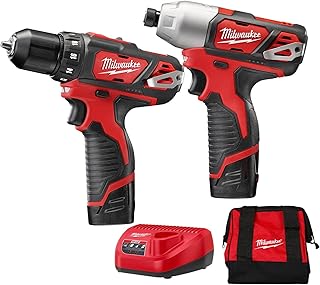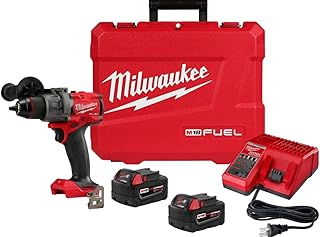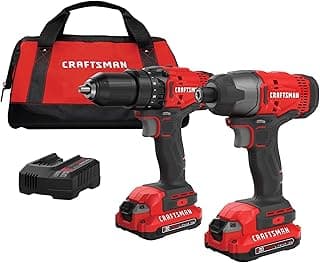Looking for the best Milwaukee cordless drill without getting lost in specs? You’re in the right place. Milwaukee’s cordless lineup has long been a go-to for contractors and serious DIYers because of its balance of power, build quality, and battery ecosystem. In this guide I’ll cut through the noise so you can choose the right tool fast. Here’s what we’ll cover: the top Milwaukee models, how the M12 platform stacks up against M18, why the FUEL variants command a premium, and which drill is best for particular tasks. Want short answers up front? Keep reading — but if you care about the details, I’ll also dig into torque, runtime, ergonomics, and price. Oh — and along the way you’ll find recommendations that link naturally to related topics like the best cordless drill, the best cordless drill and impact driver set, and the best lightweight cordless drill. Let’s get into it.
Our Top Picks:
Best Compact Power: Milwaukee Electric - M18 Compact BRUSHLESS 1/2 INCH Drill/Driver KIT
Delivering up to 550 in-lbs of torque and a max speed of 1,700 RPM, the Milwaukee M18 Compact Brushless 1/2" Drill/Driver strikes an excellent balance between power and maneuverability. Its brushless motor boosts efficiency and runtime, while the 18V platform ensures steady output for wood, metal, and everyday fastening tasks. The kit includes two 2.0Ah batteries, a charger, and a sturdy case—making it a ready-to-work setup right out of the box. The compact frame is a major win for overhead work or tight corners, though users looking for ultra-high-RPM drilling may find the speed ceiling modest compared with premium high-speed models.
From a customer standpoint, this drill is often praised for feeling lightweight yet surprisingly strong, especially for home improvement jobs and light-to-medium professional use. Many users like the smooth trigger control and long battery life from the M18 ecosystem. Some note that while it’s not the fastest drill in the category, its reliability, durability, and overall balance make it a dependable everyday tool rather than a niche, high-performance option.
Best Compact Combo: Milwaukee Electric - M18TRADE Compact BRUSHLESS 2-Tool Combo KIT
Offering both a compact 1/2" drill/driver and a 1/4" hex impact driver, the Milwaukee M18 Compact Brushless 2-Tool Combo Kit delivers a practical balance of power and portability for everyday work. The drill provides up to 550 in-lbs of torque, while the impact driver reaches speeds up to 3,600 RPM—making the set suitable for drilling, fastening, and quick screw-driving across a wide range of materials. The brushless motors contribute to cooler operation, better efficiency, and longer tool life, and the overall 18V platform ensures consistent output. At just over 9.5 lbs for the full kit, it remains easy to carry and ideal for users who frequently move between job sites. The included CP2.0 batteries keep the setup lightweight, though they naturally trade off longer runtime compared to higher-capacity packs.
From the customer perspective, the combo is often valued for how compact both tools feel without sacrificing meaningful power. Homeowners appreciate the ease of control and predictable performance, while professionals like the reliability and compatibility with existing M18 batteries. The most common feedback centers around battery life—adequate for quick tasks but requiring mid-day swaps during heavier work. Even so, users typically find the combo a strong value thanks to the durability, straightforward design, and the versatility gained from having two brushless tools in one kit.
Best Compact Brushless Drill: Milwaukee 2801-21P M18 18-Volt Lithium-Ion Compact Brushless Cordless 1/2 in
Delivering 500 in-lbs of torque and up to 1,800 RPM, the Milwaukee 2801-21P M18 Compact Brushless Drill/Driver is built for users who need dependable power in a slim, easy-to-maneuver form. Its brushless motor enhances durability, keeps heat down, and provides smoother performance during extended use. With a 1/2" chuck and solid drilling capacity—12.7 mm in metal and 1" in wood—the drill handles everyday tasks with confidence. The included 2.0Ah battery and charger make it ready for work out of the box, and its compact feel gives it a noticeable advantage for overhead use or tight spaces. While some higher-end models offer faster RPM, the balance of torque and control here fits most home improvement and light pro applications.
From a customer perspective, the 2801-21P earns praise for its strong build quality, comfortable grip, and reliable runtime within the M18 ecosystem. Many users appreciate how it feels powerful without being bulky, making it a go-to tool for repetitive drilling or fastening. The main feedback tends to be about the mid-range speed—adequate for general tasks, but not ideal for users who rely heavily on high-RPM applications. Overall, buyers often see it as a durable, no-nonsense drill that performs consistently and justifies its place in the Milwaukee lineup.
FAQs
What is the Milwaukee best drill?
There isn’t a single universal “best” — it depends on what you need — but if you measure by raw performance, versatility, and industry reputation, Milwaukee’s M18 FUEL brushless drills (and hammer drills) are consistently at the top.
What makes them stand out:
-
Brushless FUEL motor: higher peak torque, better thermal management, and more efficient power use than brushed motors.
-
Electronics and gearing: refined speed ranges and electronic protections (soft start, overload protection) improve control and durability.
-
Battery ecosystem: the M18 battery family is large, so compatibility with other tools gives practical value.
-
Build and ergonomics: rugged housings, good balance, and serviceability for trade use.
Who should pick an M18 FUEL? Pros and power-users who need high torque for framing, lag bolts, or frequent heavy work. If you want a compact everyday driver, see the "best lightweight" picks mentioned above.
What's better, Milwaukee M12 or M18?
Short answer: M12 for compact/light tasks; M18 for heavy duty. Both are excellent — but they target different use cases.
Compare them by category:
-
Size & weight: M12 is smaller and lighter — ideal for tight spaces, overhead work, and prolonged use where fatigue matters.
-
Power & torque: M18 models deliver substantially more torque and speed options; M12 is underpowered for heavy fastening or drilling large holes.
-
Battery runtime & availability: M18 batteries generally have higher capacity and longer runtimes; M12 batteries are smaller but recharge faster and the tools are lighter.
-
Tool ecosystem: M18 has a broader ecosystem (saws, grinders, heavy tools) so if you plan to build around one platform, M18 is more future-proof.
-
Cost: M12 tools and batteries are often cheaper upfront, but if you need power, M18 is worth the investment.
Pick M12 if you prioritize portability and light trade or home tasks. Pick M18 if you need sustained power and the ability to handle tougher materials.
What is the highest rated cordless drill?
“Highest rated” depends on where you look (consumer reviews, pro tests, lab torque tests), but common factors that earn high ratings are: high sustained torque, longevity (electronics & gearbox), battery efficiency, ergonomics, and serviceability.
Models that frequently appear at the top across reviews:
-
Milwaukee M18 FUEL series (drill/hammer drill variants) — praised for torque and durability.
-
DEWALT DCD/FlexVolt brushless models — competitive torque and wide availability.
-
Makita LXT brushless lineup — often lauded for balance of weight and runtime.
-
Bosch ProCore/brushless variants — noted for precision and compact designs.
How to interpret ratings: don’t only follow a single star score. Look at torque ratings (in in-lbs or Nm), RPM ranges, battery amp-hours used in tests, and real-world reports of motor heating or gearbox wear. The “highest rated” drill for a framer will differ from the highest rated for an electrician or hobbyist.
Is there a big difference between M18 and M18 FUEL?
Yes — and it’s meaningful for many users.
What “FUEL” means:
-
Brushless motor: FUEL tools use brushless motors which are more efficient, run cooler, and deliver more usable torque for their size.
-
Advanced electronics: Milwaukee often pairs brushless motors with improved motor controllers, better thermal management, and firmware that optimizes power delivery.
-
Higher performance: compared to standard M18 brushed or non-FUEL brushless variants, M18 FUEL models typically have higher peak torque, better acceleration, and sometimes longer battery life under load.
-
Price and weight: FUEL models usually cost more. In some cases they can be slightly heavier because of beefed-up internals, but design choices often offset that so perceived balance remains good.
When to choose FUEL: if you frequently work under heavy loads, need the longest tool life, or want the best power-to-size ratio. If your work is light and occasional, a non-FUEL M18 or an M12 might be a smarter value.






















